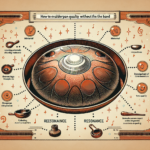<!DOCTYPE html>
<html lang="en">
<head>
<meta charset="UTF-8">
<meta name="viewport" content="width=device-width, initial-scale=1.0">
<title>Handpan Tuning Toolkit: What Every Player Should Know</title>
<style>
body {
font-family: Arial, sans-serif;
line-height: 1.6;
margin: 20px;
}
h2 {
color: #333;
}
p {
margin-bottom: 20px;
}
ul {
margin-bottom: 20px;
padding-left: 20px;
}
li {
margin-bottom: 10px;
}
</style>
</head>
<body>
<h2>An Introduction to the Handpan</h2>
<p>The handpan, a captivating and unique musical instrument, has grown in popularity in recent years. Its soothing, melodic sound enthralls both players and listeners alike. Originating from the steel pan family, the handpan is known for its distinctively harmonious tones and ethereal resonance. However, achieving the full potential of a handpan requires meticulous care and attention, especially when it comes to tuning. With the right tools and knowledge, players can ensure their handpan remains in perfect pitch, delivering the beautiful sound it was crafted to produce.</p>
<h2>Understanding Handpan Tuning</h2>
<p>Handpan tuning is an intricate process that involves adjusting the instrument's shape and tension to achieve the desired pitch. Unlike standard instruments like guitars or pianos, handpans are constructed from steel and are much more sensitive to changes in environment and handling. This sensitivity means that even subtle impacts or shifts in temperature and humidity can affect their tuning.</p>
<p>Tuning a handpan is not as straightforward as adjusting strings or keys. Each note on a handpan is created through the careful hammering of the metal surface to form a raised dome-like structure called a 'note dome'. These note domes vibrate to produce sound, and maintaining their precision is key to retaining the intended sonic output.</p>
<h2>The Importance of Regular Maintenance</h2>
<p>Regular maintenance is crucial to preserving the handpan’s tonal quality. Without consistent upkeep, the instrument may fall out of tune, which can significantly affect its sound and the overall playing experience. Players should develop a routine check-up schedule to ensure their instrument remains in optimal condition.</p>
<p>This maintenance can involve simple actions like cleaning the surface to prevent rust or more complex tasks like checking for any signs of detuning. Understanding the basic anatomy of the handpan and its specific maintenance needs can save players both time and money in the long run.</p>
<h2>Components of a Handpan Tuning Toolkit</h2>
<p>A proper handpan tuning toolkit is essential for any player who wishes to take charge of their instrument's upkeep. The toolkit typically includes:</p>
<ul>
<li><strong>Tuning Hammers:</strong> Specialized tools that are used to adjust the pitch of the note domes through gentle tapping.</li>
<li><strong>Strobe Tuner:</strong> A precise electronic tuner that helps players identify the exact frequency of each note. This tool ensures that each note dome is perfectly in tune.</li>
<li><strong>Microfiber Cloth:</strong> Used for safely cleaning the surface of the handpan without scratching or damaging the metal.</li>
<li><strong>Lubrication Oil:</strong> Helps protect the handpan from rust and other environmental damage.</li>
</ul>
<h2>The Process of Handpan Tuning</h2>
<p>The tuning process of a handpan requires careful attention and a gentle touch. It involves the following steps:</p>
<ul>
<li>Start by identifying the notes that are out of tune using a strobe tuner. Play each note dome and observe the tuner readings.</li>
<li>Using the tuning hammer, make subtle adjustments to the out-of-tune notes. Slightly tap the relevant part of the note dome to adjust its frequency. Always start with softer taps to avoid overcorrecting.</li>
<li>Constantly recheck the notes with the strobe tuner to ensure each note reaches the desired pitch. Take your time to make incremental adjustments.</li>
<li>After tuning, inspect the overall surface of the handpan to ensure there are no new dents or scratches.</li>
<li>Finish by gently cleaning the instrument with a microfiber cloth and applying a light layer of lubrication oil.</li>
</ul>
<h2>When to Seek Professional Help</h2>
<p>While players can perform basic tuning adjustments, there are times when professional expertise is necessary. If a handpan shows significant signs of detuning, structural damage, or rusting that cannot be corrected with basic tools, it is advisable to seek help from a professional tuner. Professional tuners have the experience and tools needed to restore the handpan to its original sound quality.</p>
<p>Moreover, considering the handcrafted nature of handpans, improper tuning attempts by inexperienced players could lead to irreversible damage. Therefore, understanding the limits of your tuning skills is vital to ensuring the longevity of your instrument.</p>
<h2>Conclusion</h2>
<p>The handpan is a beautiful yet delicate instrument that requires dedicated care and maintenance. Its unique structure demands special attention to tuning, and with the right toolkit and knowledge, players can keep their handpans sounding exceptional. By understanding the nuances of handpan tuning and maintenance, players can truly enjoy the profound musical landscapes their instrument can create. Regular check-ups, gentle handling, and the occasional professional tune-up can go a long way in preserving the enchanting sound of the handpan.</p>
<h2>FAQs About Handpan Tuning</h2>
<h3>1. How often should I tune my handpan?</h3>
<p>The frequency of tuning largely depends on usage and environmental factors. For regular players, a monthly check-up may suffice, while occasional players might tune bi-monthly. Always monitor for changes in sound to determine when tuning is needed.</p>
<h3>2. Can I tune my handpan myself?</h3>
<p>Yes, players can perform basic tuning adjustments with the right tools and knowledge. However, for significant tuning or repair needs, consulting a professional is recommended.</p>
<h3>3. What should I do if my handpan gets dented?</h3>
<p>Minor dents might not affect the sound significantly, but larger dents can cause detuning. It is best to have serious dents assessed and repaired by a professional to avoid further damage.</p>
<h3>4. Is it normal for my handpan to detune over time?</h3>
<p>Yes, due to the nature of the material and construction, handpans can naturally detune over time, especially with frequent play and environmental exposure. Regular maintenance can help manage this.</p>
<h3>5. What environmental factors affect handpan tuning?</h3>
<p>Temperature, humidity, and exposure to direct sunlight can all impact the tuning stability of a handpan. Keeping your handpan in a stable environment is key to maintaining its sound quality.</p>
</body>
</html>Handpan Tuning Toolkit: What Every Player Should Know

Leave a comment




